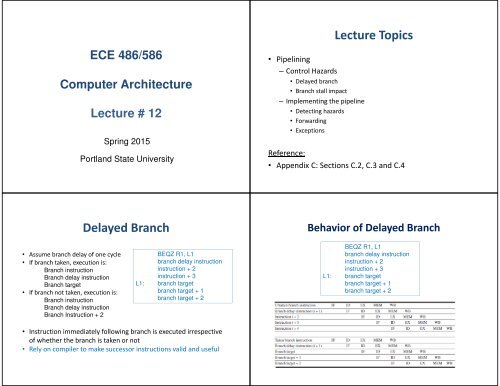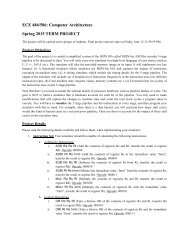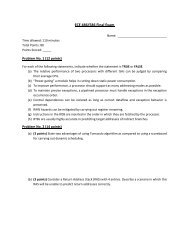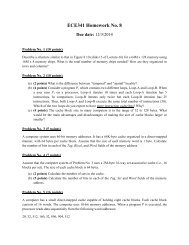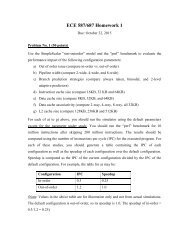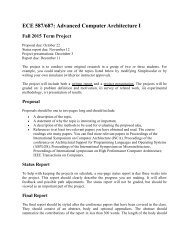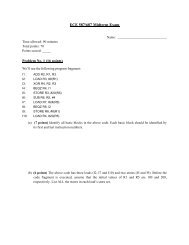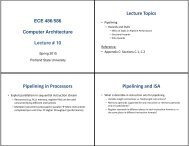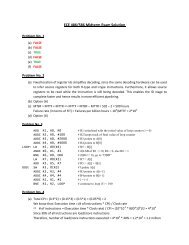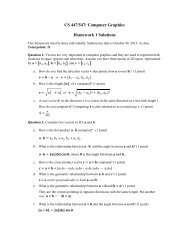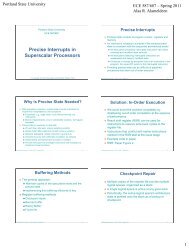Delayed Branch
Lecture Topics Delayed Branch - Portland State University
Lecture Topics Delayed Branch - Portland State University
Create successful ePaper yourself
Turn your PDF publications into a flip-book with our unique Google optimized e-Paper software.
Lecture Topics<br />
ECE 486/586<br />
Computer Architecture<br />
Lecture # 12<br />
Spring 2015<br />
Portland State University<br />
• Pipelining<br />
– Control Hazards<br />
• <strong>Delayed</strong> branch<br />
• <strong>Branch</strong> stall impact<br />
– Implementing the pipeline<br />
Reference:<br />
• Detecting hazards<br />
• Forwarding<br />
• Exceptions<br />
• Appendix C: Sections C.2, C.3 and C.4<br />
<strong>Delayed</strong> <strong>Branch</strong><br />
Behavior of <strong>Delayed</strong> <strong>Branch</strong><br />
• Assume branch delay of one cycle<br />
• If branch taken, execution is:<br />
<strong>Branch</strong> instruction<br />
<strong>Branch</strong> delay instruction<br />
<strong>Branch</strong> target<br />
• If branch not taken, execution is:<br />
<strong>Branch</strong> instruction<br />
<strong>Branch</strong> delay instruction<br />
<strong>Branch</strong> Instruction + 2<br />
BEQZ R1, L1<br />
branch delay instruction<br />
instruction + 2<br />
instruction + 3<br />
L1: branch target<br />
branch target + 1<br />
branch target + 2<br />
BEQZ R1, L1<br />
branch delay instruction<br />
instruction + 2<br />
instruction + 3<br />
L1: branch target<br />
branch target + 1<br />
branch target + 2<br />
• Instruction immediately following branch is executed irrespective<br />
of whether the branch is taken or not<br />
• Rely on compiler to make successor instructions valid and useful
Scheduling the <strong>Branch</strong> Delay Slot<br />
Impact of Control Hazards<br />
• Impact of control hazards on performance depends on:<br />
– Frequency of branch instructions<br />
– Accuracy of branch prediction<br />
– Stall penalty for each misprediction<br />
• 1 or 2 cycles on a simple 5-stage MIPS<br />
• Higher in deeper pipelines and more complex processors<br />
Example<br />
Another Example<br />
• Assume that branches comprise 20% of all instructions. Also<br />
assume that the branch prediction is 80% accurate and incurs a 2<br />
cycle stall on each misprediction. What is the impact of control<br />
hazards on the CPI of the pipelined processor? Ignore all other<br />
sources of pipeline hazards.<br />
• Solution:<br />
CPI without control hazards = 1<br />
Added CPI due to control hazards = <strong>Branch</strong> frequency * (1 – <strong>Branch</strong><br />
prediction accuracy) * Stall penalty = 20% * (1 - 80%) * 2 = 0.08<br />
CPI with control hazards = 1 + 0.08 = 1.08<br />
Speedup of “predicted-not-taken” over “stall pipeline” = 1.56 / 1.38 = 1.13
MIPS Datapath<br />
Implementation of MIPS Pipeline<br />
Pipelining the MIPS Datapath<br />
Events in Pipeline Stages
Detecting Hazards<br />
Forwarding Results to ALU<br />
What Makes Pipelining Difficult<br />
to Implement<br />
• Exceptions<br />
– Interruptions to “normal” program flow<br />
– Usually outside of program’s control<br />
– Common “mechanism”<br />
• Save processor state (PC, flags etc.)<br />
• Handle the exception<br />
• Resume execution from point of interruption<br />
Exceptions<br />
• Common mechanism for variety of reasons<br />
– I/O device request<br />
– User program invoking OS call<br />
– Breakpoints<br />
– Integer arithmetic overflow<br />
– Page fault<br />
– Misaligned memory address reference<br />
– Memory protection violation<br />
– Undefined instruction
Exceptions<br />
• Variety of names used for different systems<br />
– Exception<br />
– Trap<br />
– Fault<br />
– Interrupt<br />
– Machine check<br />
Exceptions<br />
• Can be characterized along 5 independent axes:<br />
– Synchronous vs. Asynchronous<br />
– User requested vs. Coerced<br />
– User maskable vs. user nonmaskable<br />
– Within vs. between instructions<br />
– Resume vs. terminate<br />
Exceptions<br />
Exceptions in MIPS<br />
• Most difficulty arises with exceptions that occur within<br />
instructions and which must permit resumption of the program<br />
– Requires “restartable” pipeline<br />
• Instruction is “in execution” and has been “partly executed”<br />
• Succeeding instructions may also be in execution<br />
– “Precise” vs. “Imprecise” exceptions<br />
• Precise: pipeline can be “stopped” such that instructions just before the<br />
faulting instruction are completed but the faulting instruction and those<br />
following are able to be restarted correctly<br />
Pipeline Stage<br />
IF<br />
IF<br />
IF<br />
ID<br />
EX<br />
MEM<br />
MEM<br />
MEM<br />
WB<br />
Exceptions<br />
Page fault on instruction fetch<br />
Misaligned memory access<br />
Memory protection violation<br />
Undefined/illegal opcode<br />
Arithmetic exception<br />
Page fault on data fetch<br />
Misaligned memory reference<br />
Memory protection violation<br />
None
Exceptions in MIPS<br />
• Multiple exceptions can occur in same clock cycle:<br />
LD R2, 100(R3)<br />
; page fault in MEM<br />
ADD R5, R6, R7<br />
; arithmetic exception in EX<br />
• Exceptions may occur out of order:<br />
LD R2, 100(R3)<br />
ADD R5, R6, R7<br />
; page fault in MEM<br />
; page fault in IF (occurs earlier)


